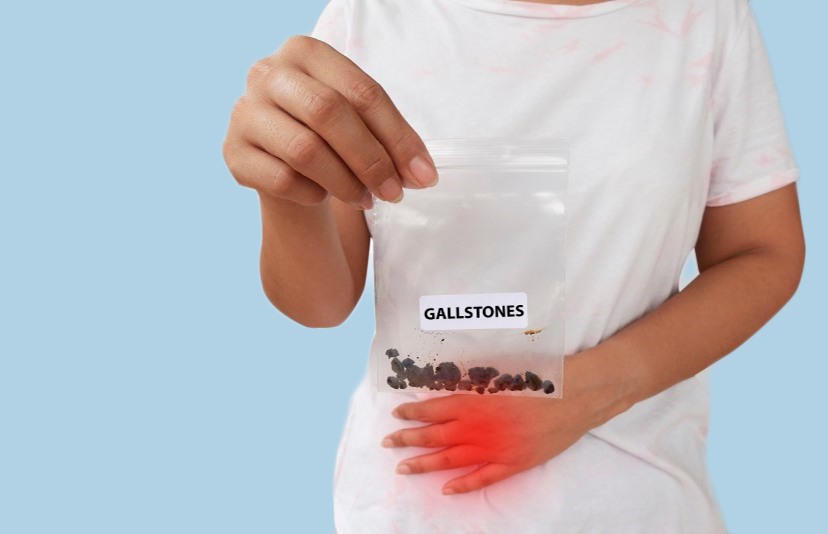
What is the procedure for gallstones removal?
The gallbladder is a pear-shaped organ that stores a digestive fluid called the bile. If the gallbladder stops functioning efficiently, hard fragments are formed and these are called gallstones. These stones can grow to be as small as a grain of sand to as big as that of a golf ball in extreme cases.
Gallstones do not go away on their own, and in certain instances, the doctor may suggest surgically removing the gallbladder. This procedure is called the cholecystectomy.
Why is cholecystectomy done?
Cholecystectomy surgery is recommended when a patient experiences the following symptoms:
- Pancreatic inflammation due to gallstones
- Cholelithiasis - Gallstones in the gallbladder
- Choledocholithiasis - Gallstones in the bile duct
- Cholecystitis - Gallbladder inflammation
What are the different types of gallbladder surgeries?
A gallbladder can be removed in two ways based on the surgeon’s recommendation:
- Open surgery – Patients with bleeding disorders usually require open surgery. For this procedure, the surgeon would make incisions that are 5 to 7 inches long near the belly. To get a better view of the liver and gallbladder, the surgeon will pull back the muscle and tissue, and then surgically removes the gall bladder. Other patients who may require gallbladder removal are obese individuals, patients with gallbladder disease and women going through their last trimester of pregnancy.
- Laparoscopic cholecystectomy – This surgical procedure does not require large incisions in the belly. Instead, four small cuts are made and a very thin flexible tube containing a video camera is inserted into the belly. The tiny camera gives a better view of the gallbladder. The surgeon is able to view the camera feed on a monitor, and surgical instruments are inserted through other incisions to remove the gallbladder. If there is a possibility of gallstones, the surgeon will recommend an X-ray or ultrasound scans to confirm the presence of gallstones. Laparoscopic procedures generally take one or two hours and are also called “keyhole surgery”.
Both these surgeries are performed under general anesthesia.
What are the symptoms that indicate the need for gallbladder removal?
The most common symptoms associated with gallbladder removal surgery are:
- Fever
- Jaundice
- Nausea
- Abdominal pain on the right side that reaches the back of the shoulder
- Bloated feeling
What are the benefits of cholecystectomy?
When the gall bladder is removed, it reduces pain and effectively treats the infection. If left untreated, the pain and infection may get worse.
The benefits of the procedure are:
- Less complications
- High recovery rate
- Small wounds and less scars
- Less pain
What are the risk factors of cholecystectomy?
There are certain risk factors that can develop when the gallbladder is removed. They are:
- Leakage of bile in the body
- Hernia
- Complications due to anesthesia
- Numbness in the surgical area
- Infection in the urinary tract
- Scars due to incisions
- Abdominal infection or inflammation
- Bile ducts, liver or intestinal injury
- Bleeding
What can you expect during post operative care for gallbladder removal?
The cholecystectomy procedure gives relief from pain and discomfort caused due to gallstones. This procedure effectively stops gallstones from recurring. After the procedure, patients may notice loose stool when defecating, and this symptom tends to resolve on its own over time. If there are any other changes in the bowel habits post-surgery, it is advisable to consult a doctor.
Patients who opted for laparoscopic cholecystectomy cannot go back to work for a few weeks. They require more time to rest and recover when compared to patients who opted for open surgery.
The following are some tips that can help you recover after having your gallbladder removed:
- Drink plenty of water
- Eat foods rich in fiber that can help your bowel movements
- Take care of your wounds
- Take your prescribed medications on time
- Walk every day to prevent blood clots
- Avoid lifting heavy items
- Increase the level of physical activity gradually, as advised by the doctor

Why Choose Apollo Healthcare?
Established By Dr Prathap C Reddy In 1983, Apollo Healthcare Has A Robust Presence Across The Healthcare Ecosystem. From Routine Wellness & Preventive Health Care To Innovative Life-Saving Treatments And Diagnostic Services, Apollo Hospitals Has Touched More Than 120 Million Lives From Over 120 Countries, Offering The Best Clinical Outcomes.
7,000+Healing Hands
4,000+Pharmacies
170+primary care & diagnostic clinics
70+Hospitals






